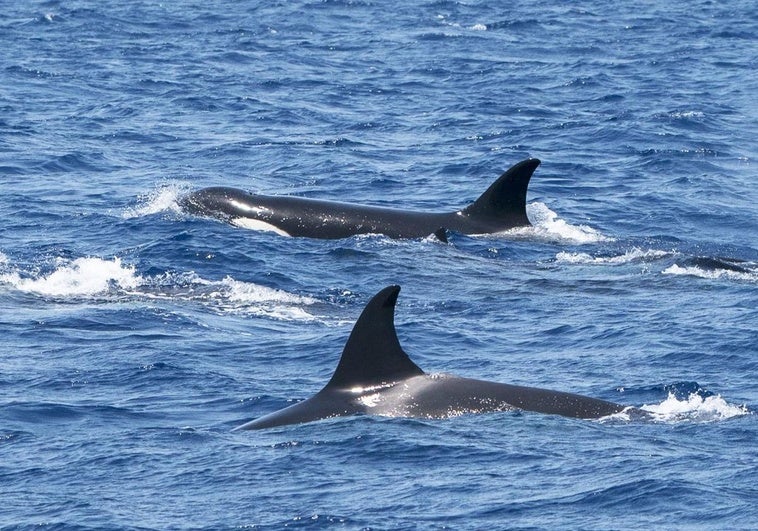
Why have there been fewer killer whale 'attacks' on sailboats in the Strait of Gibraltar recently?
The number has fallen by 80% since 2023 and most experts agree that the incidents are not intentional attacks, because if they were, it would be very easy for the orcas to sink the boats
Sailboats in the Strait of Gibraltar are operating more calmly these days than they have done in the last five years. The number of killer whale 'attacks' has dropped by 43% between January and May compared to the figures recorded since 2021. Only 25 such interactions have been recorded in 2025, exactly half the number recorded in 2024 and far fewer than the 61 in 2023 and the 42 in 2022. Only in 2021 were there fewer - 21.
The data comes from the Orca Atlántica group - one of the reference organisations in the study of these cetaceans, which were named gladis in homage to a name used in the past: orca gladiator.
"The drop compared to 2023 is 80%," said Renaud de Stephanis, coordinator and president of the group for conservation, information and study of cetaceans (Circe), which has been studying the Iberian killer whale since 1998 and which gathers its information from rescue operations concerning vessels damaged in the attacks.
There are two reasons behind the decline of a surprising behaviour that began in the summer of 2020, which amounted to 877 of these interactions and the sinking of seven boats (five sailboats and two small fishing boats). The first is obvious: if you want to avoid killer whales, the best thing to do is not to pass through the areas where they tend to be found. "80% of these incidents have taken place in an area of the Strait of Gibraltar that is three square kilometres in size," said De Stephanis. It is at this point that the orcas chase bluefin tuna - their main source of food.
Separate orcas
Spain's Ministry of Ecological Transition's recommendations are to avoid this area, especially between April and August, and if not, to sail "as close as possible to the coast within safe limits". In the event of an encounter, it urges not to stop the boat and instead to move towards shallower waters. "Stopping the boats - an advice that was given for a while - increased the interactions," said the Circe representative. "If you do that, they break the rudder, but if you move, it makes it harder for them to hit and they do it with less force," he added.
Alfredo López, spokesperson for Orca Atlántica, does not deny the effectiveness of sailing close to the coast. However, this measure was applied in 2023, coinciding with the height of attacks. For this reason, López believes that the reason behind the decline is that the most active gladioli have separated. "In July, they had split up between the Strait of Gibraltar and the Bay of Biscay. The specimens that interact very frequently when they are together, reduce their interactions with sailboats when they are separated," he said. "We don't know why some years they are all closer together and other years they are further apart. It gives the impression that they follow two-year cycles. All we can say is that it happens and that we're still missing pieces of the puzzle."
The most widespread theory about the cause of these attacks is that it is a game. According to a report published just over a year ago by the IWC international whaling commission, in the face of the overabundance of tuna, the youngest specimens get bored and seek entertainment by colliding with the sailing vessels in the Strait of Gibraltar. Most experts agree that the incidents are not intentional attacks, because if they were, it would be very easy for the orcas to sink the boats.
Post-traumatic stress
However, López sees something else. Of the 45 Iberian killer whales, only 16 are considered to be gladis, which, according to him, are the ones getting close to boats. De Stephanis disagrees, stating that all of the whales participate in these games. Of the 16, only one would be an adult specimen - the white gladis. She was the one that first rammed a boat in the summer of 2020. Born in 2005 or 2013 - there is no agreement on this point - she would do it not for revenge, as has been published. "Cetaceans in the wild do not know this behaviour," said López, explaining that orcas launch attacks to protect the pod after having suffered "some trauma".
The young specimens would imitate this behaviour until, as adults, they would abandon it. It would be a fad that suddenly disappears, like what happened years ago with another pod of cetaceans that used to carry salmon on their heads like hats. "For them, it could indeed be a game," said Gorka Ocio, from the company Verballenas, dedicated to whale-watching on the Basque coast.
The white gladis maintained this behaviour even after becoming a mother, which would indicate, according to López, that she puts the pod ahead of her offspring, despite female orcas being extremely protective of their babies due to the high mortality rates in the first months of life. "It's as if she is obsessed or suffering from post-traumatic stress. What drives her to act is stronger than motherhood itself. In her case it can't be boredom, it doesn't make sense."
